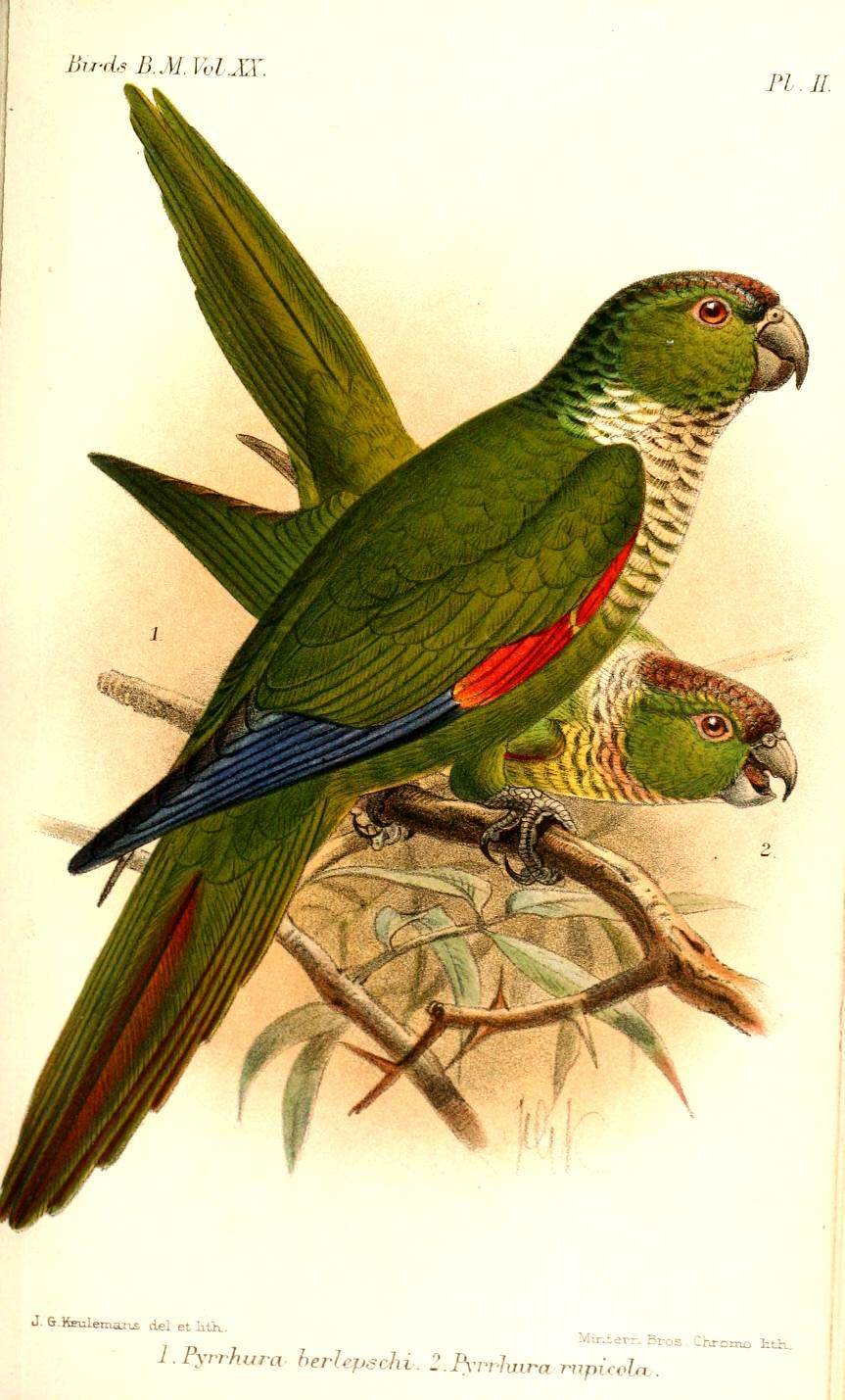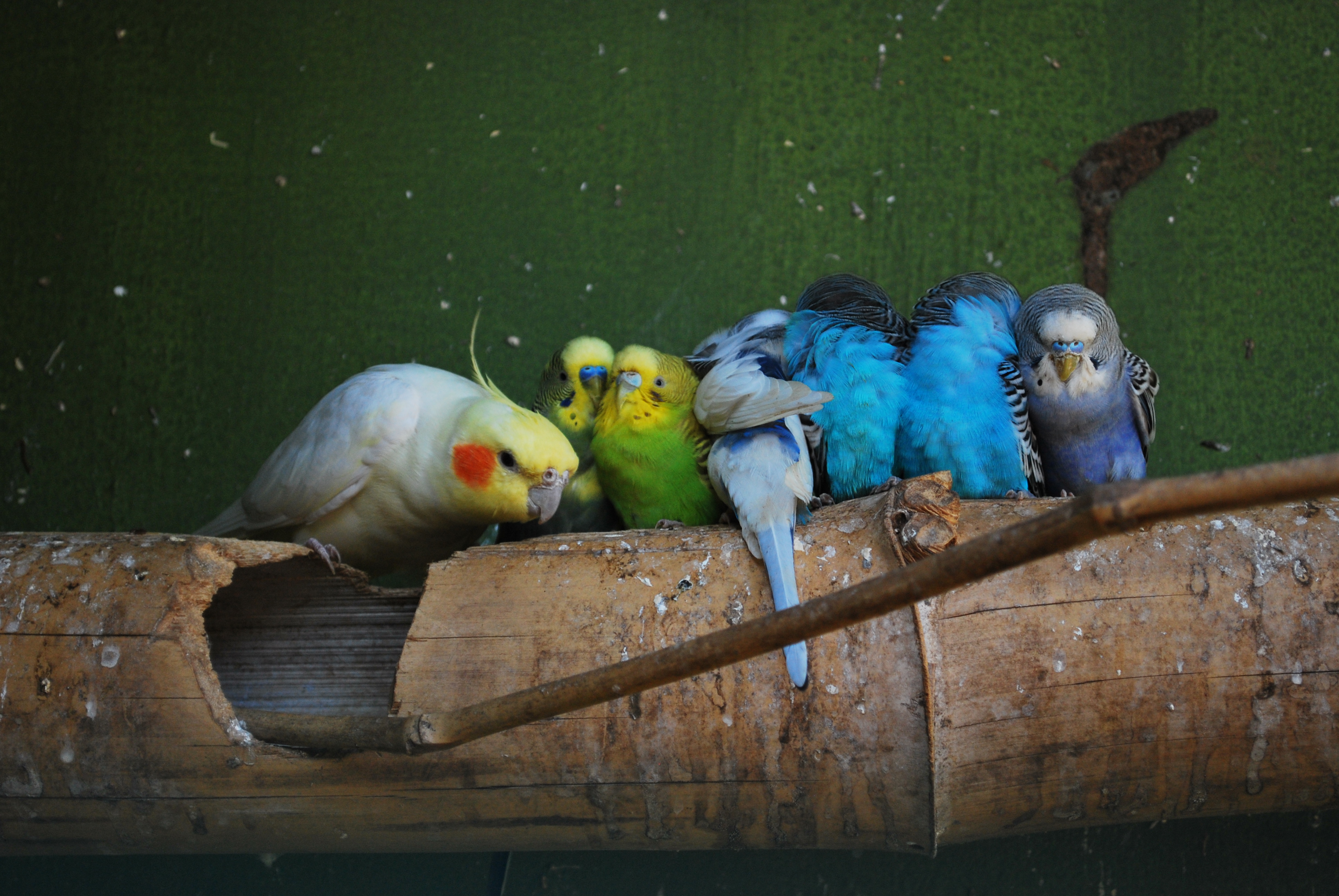|
Pyrrhura
''Pyrrhura'' (Greek Red/Fire Tail) is a genus of parrots in the Arini tribe. They occur in tropical and subtropical South America and southern Central America (Panama and Costa Rica). Most are restricted to humid forest and adjacent habitats, but one species, the blaze-winged parakeet, prefers deciduous or gallery woodland, and another, the Pfrimer's parakeet, is restricted to dry regions. Some species are highly endangered. Depending on the species, the total length range from . All have long, pointed tails, a mainly green plumage, and a relatively narrow, dark greyish to white eye-ring. Many have scaly or barred chest-patterns and a whitish, pale grey, buff or reddish ear-patch. They typically move around in small, noisy flocks, flying swiftly at or below canopy level. Once settled in a tree they tend to be silent (especially if aware of danger) and difficult to spot. They nest in a tree-crevice. Some species are popular in aviculture, where they are commonly referred t ... [...More Info...] [...Related Items...] OR: [Wikipedia] [Google] [Baidu] |
Green-cheeked Parakeet
The green-cheeked parakeet (''Pyrrhura molinae''), also sometimes known as the green-cheeked conure in aviculture, is a species of bird in subfamily Arinae of the family Psittacidae, the African and New World parrots. It is found in Argentina, Bolivia, Brazil, and Paraguay.Remsen, J. V., Jr., J. I. Areta, E. Bonaccorso, S. Claramunt, A. Jaramillo, D. F. Lane, J. F. Pacheco, M. B. Robbins, F. G. Stiles, and K. J. Zimmer. 30 January 2023. Species Lists of Birds for South American Countries and Territories. https://www.museum.lsu.edu/~Remsen/SACCCountryLists.htm retrieved January 30, 2023 Taxonomy and systematics The green-cheeked parakeet has six subspecies: *''P. m. flavoptera'' Maijer, Herzog, Kessler, Friggens & Fjeldsa, 1998 *''P. m. molinae'' ( Massena & Souance, 1854) *''P. m. phoenicura'' ( Schlegel, 1864) *''P. m. hypoxantha'' ( Salvadori 1899) *''P. m. restricta'' Todd, 1947 *''P. m. australis'' Todd, 1915 Subspecies ''P. m. hypoxantha'' was previously known as '' ... [...More Info...] [...Related Items...] OR: [Wikipedia] [Google] [Baidu] |
Maroon-bellied Parakeet
__NOTOC__ The maroon-bellied parakeet (''Pyrrhura frontalis'') is a small parrot found from southeastern Brazil to north-eastern Argentina, including eastern Paraguay and Uruguay. It is also known as the reddish-bellied parakeet, and in aviculture it is usually referred to as the maroon-bellied conure, reddish-bellied conure or brown-eared conure. Taxonomy The maroon-bellied parakeet was species description, formally described in 1818 by the French ornithologist Louis Pierre Vieillot, Louis Vieillot and given the binomial name ''Psittacus frontalis''. Vieillot based his description on "La Perruche Ara à bandeau rouge" that had been described and illustrated by François Levaillant in 1801. The specific epithet ''frontalis'' is Modern Latin meaning "fronted" or "browed". Levaillant specified the type locality (biology), locality as Brazil but Vieillot mistakenly changed this to Cayenne in French Guiana where the species does not occur. The locality is now restricted to the state o ... [...More Info...] [...Related Items...] OR: [Wikipedia] [Google] [Baidu] |
Pfrimer's Parakeet
Pfrimer's parakeet (''Pyrrhura pfrimeri'') is a non-migratory species within the parrot family Psittacidae. It also is known as Pfrimer's conure, Goias parakeet, and maroon-faced conure. The Pfrimer's parakeet has been qualified as endangered by the IUCN and BirdLife International since 2007. It is endemic to the Goiás and Tocantins regions of Brazil. It is mainly found within a belt of dry deciduous and semi-deciduous areas of the Caatinga forest.Handbook of the Birds of the World https://www.hbw.com/species/goias-parakeet-pyrrhura-pfrimeri It was considered a subspecies of the white-eared parakeet, as ''Pyrrhura leucotis pfrimeri''. The split was based on range, differences in habitat and distinctive differences in plumage (it is the only member of the P. leucotis complex where the pale patch on the ear-coverts is greatly reduced). A recent study based on mtDNA has confirmed its status as a distinct species. The population of Pfrimer's parakeet is currently decreasing, with ... [...More Info...] [...Related Items...] OR: [Wikipedia] [Google] [Baidu] |
Maroon-bellied Parakeet
__NOTOC__ The maroon-bellied parakeet (''Pyrrhura frontalis'') is a small parrot found from southeastern Brazil to north-eastern Argentina, including eastern Paraguay and Uruguay. It is also known as the reddish-bellied parakeet, and in aviculture it is usually referred to as the maroon-bellied conure, reddish-bellied conure or brown-eared conure. Taxonomy The maroon-bellied parakeet was species description, formally described in 1818 by the French ornithologist Louis Pierre Vieillot, Louis Vieillot and given the binomial name ''Psittacus frontalis''. Vieillot based his description on "La Perruche Ara à bandeau rouge" that had been described and illustrated by François Levaillant in 1801. The specific epithet ''frontalis'' is Modern Latin meaning "fronted" or "browed". Levaillant specified the type locality (biology), locality as Brazil but Vieillot mistakenly changed this to Cayenne in French Guiana where the species does not occur. The locality is now restricted to the state o ... [...More Info...] [...Related Items...] OR: [Wikipedia] [Google] [Baidu] |
Blaze-winged Parakeet
The blaze-winged parakeet (''Pyrrhura devillei''), known as the blaze-winged conure in aviculture, is a species of bird in subfamily Arinae of the family Psittacidae, the African and New World parrots. It is found in Brazil, Bolivia, Paraguay, and possibly Argentina.Remsen, J. V., Jr., J. I. Areta, E. Bonaccorso, S. Claramunt, A. Jaramillo, D. F. Lane, J. F. Pacheco, M. B. Robbins, F. G. Stiles, and K. J. Zimmer. 30 January 2023. Species Lists of Birds for South American Countries and Territories. https://www.museum.lsu.edu/~Remsen/SACCCountryLists.htm retrieved January 30, 2023 Taxonomy and systematics The blaze-winged parakeet is closely related to the maroon-bellied parakeet (''P. frontalis'') and they may be conspecific. The blaze-winged parakeet hybridizes with ''P. f. chiripepe'' where their ranges overlap in Paraguay.Remsen, J. V., Jr., J. I. Areta, E. Bonaccorso, S. Claramunt, A. Jaramillo, D. F. Lane, J. F. Pacheco, M. B. Robbins, F. G. Stiles, and K. J. Zimmer. Versio ... [...More Info...] [...Related Items...] OR: [Wikipedia] [Google] [Baidu] |
Conure
Conures are a diverse, loosely defined group of small to medium-sized parrots. They belong to several genus, genera within a long-tailed group of the New World parrot subfamily Arinae. Most conures belong to the tribe Arini (tribe), Arini, though ''Myiopsitta'' is an exception. The term "conure" is used primarily in aviculture, bird keeping, though it has appeared in some scientific journals. The American Ornithologists' Union uses the generic term ''parakeet'' for all species elsewhere called ''conure'', though Joseph Forshaw, a prominent Australian ornithologist, uses ''conure''. Description Conures are either large parakeets or small parrots found in the Western Hemisphere. They are analogous in size and way of life to Afro-Eurasia's rose-ringed parakeets or the Neophema, Australian parakeets. All living conure species live in Central America, Central and South America. The extinct ''Conuropsis carolinensis'', or Carolina parakeet was an exception. Conures are often cal ... [...More Info...] [...Related Items...] OR: [Wikipedia] [Google] [Baidu] |
Neotropical Parrots
The neotropical parrots or New World parrots comprise about 150 species in 32 genera found throughout South and Central America, Mexico, the Caribbean islands and the southern United States. Among them are some of the most familiar and iconic parrots, including the blue and gold macaw, sun conure, and yellow-headed amazon. The parrots of the New World have been known to Europeans since Columbus remarked upon them in his journal in 1492. Systematic descriptions of the birds were first available in German naturalist Georg Marcgraf's ''Historia Naturalis Brasiliae'' published in 1648, and English naturalist Mark Catesby's two-volume ''Natural History of Carolina, Florida and the Bahama Islands'' published in London in 1731 and 1743. Several species and one genus have become extinct in recent centuries. A second genus is extinct in the wild. Over a third of the extant species are classified as threatened by the IUCN. A few of these are in imminent danger of extinction with fe ... [...More Info...] [...Related Items...] OR: [Wikipedia] [Google] [Baidu] |
Charles De Souancé
Charles de Souancé (2 May 1823 – 23 January 1896) was a French ornithologist and a purser in the French Navy, more precisely "Commissaire de la Marine". He made many studies on the ornithological collection of his uncle François Victor Masséna and described several new species of parrots (Psittacidae) in the scientific journal ''Revue et Magazin de Zoologie''. A subspecies of the maroon-tailed parakeet, ''Pyrrhura melanura souancei'', is named for him. Published works * ''Description de quelques nouvelles espèces d'oiseaux de la famille des psittacidés'', with François Victor Masséna, 1854 – Description of some new species of birds within the family Psittacidae. * ''Iconographie des perroquets, non figurés dans les publications de Levaillant et de M. Bourjot Saint-Hilaire'', in collaboration with Charles Lucien Bonaparte Charles Lucien Jules Laurent Bonaparte, 2nd Prince of Canino and Musignano (24 May 1803 – 29 July 1857) was a French naturalist and ornit ... [...More Info...] [...Related Items...] OR: [Wikipedia] [Google] [Baidu] |
Charles Lucien Bonaparte
Charles Lucien Jules Laurent Bonaparte, 2nd Prince of Canino and Musignano (24 May 1803 – 29 July 1857) was a French naturalist and ornithology, ornithologist, and a nephew of Napoleon. Lucien and his wife had twelve children, including Cardinal Lucien Bonaparte (cardinal), Lucien Bonaparte. Life and career Bonaparte was the son of Lucien Bonaparte and Alexandrine de Bleschamp. Lucien was a younger brother of Napoleon I of France, Napoleon I, making Charles the emperor’s nephew. Born in Paris, he was raised in Italy. On 29 June 1822, he married his cousin, Zénaïde Laetitia Julie Bonaparte, Zénaïde, in Brussels. Soon after the marriage, the couple left for Philadelphia in the United States to live with Zénaïde's father, Joseph Bonaparte (who was also the paternal uncle of Charles). Before leaving Italy, Charles had already discovered a Old World warbler, warbler new to science, the moustached warbler, and on the voyage he collected specimens of a new Wilson's storm-petrel ... [...More Info...] [...Related Items...] OR: [Wikipedia] [Google] [Baidu] |
Genus
Genus (; : genera ) is a taxonomic rank above species and below family (taxonomy), family as used in the biological classification of extant taxon, living and fossil organisms as well as Virus classification#ICTV classification, viruses. In binomial nomenclature, the genus name forms the first part of the binomial species name for each species within the genus. :E.g. ''Panthera leo'' (lion) and ''Panthera onca'' (jaguar) are two species within the genus ''Panthera''. ''Panthera'' is a genus within the family Felidae. The composition of a genus is determined by taxonomy (biology), taxonomists. The standards for genus classification are not strictly codified, so different authorities often produce different classifications for genera. There are some general practices used, however, including the idea that a newly defined genus should fulfill these three criteria to be descriptively useful: # monophyly – all descendants of an ancestral taxon are grouped together (i.e. Phylogeneti ... [...More Info...] [...Related Items...] OR: [Wikipedia] [Google] [Baidu] |
Aviculture
Aviculture is the practice of keeping and breeding birds, especially of wild birds in captivity. Aviculture Aviculture is the practice of keeping birds (class '' Aves'') in captivity in controlled conditions, normally within the confines of a cage or an aviary. Some reasons for aviculture are: breeding birds as a hobby, a business like a zoo, or sometimes for research and conservation purposes to preserve and protect some endangered avian species that are at risk due to habitat destruction, the illegal wildlife trade, diseases, and natural disasters. Aviculture encourages conservation, provides education about avian species, provides companion birds for the public, and includes research on avian behaviour. Popular birds people like to keep and breed include budgerigars, cockatiels, finches, macaws, domestic canaries, columbidae (pigeons and doves), loriini (lories and lorikeets), cockatoos, conures, and African grey parrots. Avicultural societies In the UK, the Avicu ... [...More Info...] [...Related Items...] OR: [Wikipedia] [Google] [Baidu] |



